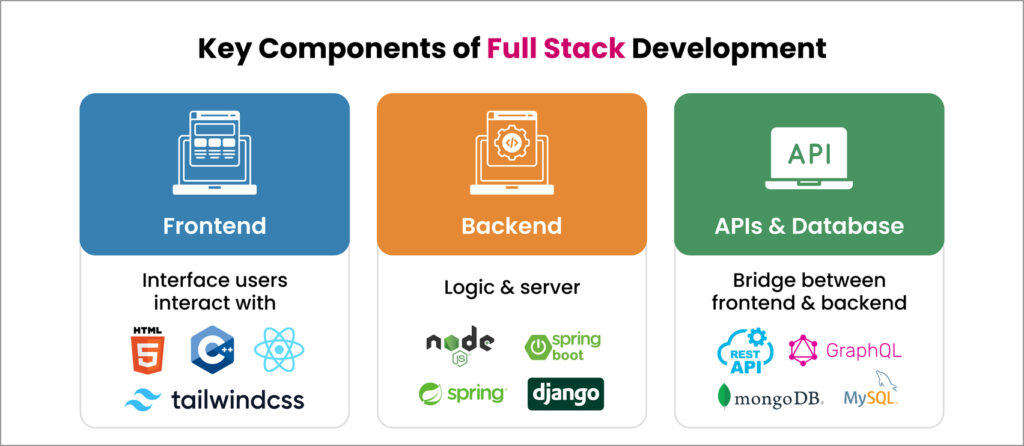1. Introduction
Web application development has always been—and will continue to be—one of the most in-demand career fields in 2025 and beyond. As businesses shift to digital and user expectations grow, skilled developers who bring websites and apps to life are more essential than ever.
But here’s the catch:
But many beginners (and even some professionals) struggle with understanding the difference between front end and back end and full stack roles.
So…
What do these roles really mean?
How are they different?
And which one is right for your career?
In this blog, we’ll break down the frontend vs backend vs full stack debate to help you:
Understand the responsibilities of each role
Learn the tools and technologies they use
Gauge the learning curve involved
Explore career opportunities and salary expectations
Let’s also agree on this:
There’s no one-size-fits-all answer in the front end vs back end vs full stack discussion—it’s all about what aligns with your interests.
2. Why Understanding These Roles Matters
The demand for developers is skyrocketing as smart apps, AI-driven platforms, and smooth user experiences become standard.Whether it’s a startup, unicorn, or traditional company going digital, they all need developers who can convert ideas into real, working applications.
Here’s a breakdown in the context of frontend vs backend vs full stack roles:
Frontend developers create the visual elements users engage with, while backend developers manage the behind-the-scenes logic, databases, and security. Full stack developers do both—building complete applications end-to-end.
Average Salary Range in India (2025)
Typical Salary Range in India (2025)
Junior Frontend Developer: ₹6–10 LPA
Junior Backend Developer: ₹7–12 LPA
Junior Full Stack Developer: ₹8–14 LPA

3. Criteria to Understand the Differences Clearly
This comparison simplifies the difference between front end and back end and full stack development for easier understanding.
| Criteria | Frontend | Backend | Full Stack |
|---|---|---|---|
| Area of Responsibility | UI/UX, user interaction | Server logic, data handling | Both frontend + backend |
| Key Tools | HTML, CSS, JS, React, Vue | Node.js, Python, Java, SQL | MERN, MEAN, mix of both |
| Learning Curve | Easier start, more visual | Logic-heavy, steeper | Time-intensive, but holistic |
| Career Paths | UI/UX Designer, Web Dev | DevOps, Backend Architect | Tech Lead, Product Dev |
| Best Personality Fit | Visual, creative | Analytical, logical | Curious, multi-tasker |
4. Deep Dive: Frontend vs Backend vs Full Stack
A. Frontend Development
What it means:
All the elements a user sees and engages with on a website or app.
Key Technologies:
HTML, CSS, JavaScript, React, Vue, Bootstrap
Real-World Example:
The layout of a shopping site, buttons that change on hover, smooth animations.
Best For:
Creative thinkers who love clean design, aesthetics, and crafting user experiences.
B. Backend Development
What it means:
The engine that runs the app—server-side logic, data flow, APIs, and databases.
Key Technologies:
Node.js, Python, Java, PHP, SQL, MongoDB
Real-World Example:
When you log in to Netflix, the backend checks your account and pulls up your watchlist.
Best For:
Analytical minds who enjoy building systems and solving complex problems.
C. Full Stack Development
What it means:
Master of both worlds—frontend and backend.
Key Technologies:
MERN (MongoDB, Express, React, Node), MEAN (Angular instead of React)
Real-World Example:
A single developer builds both the user interface and backend logic of a blog platform.
Best For:
Versatile learners, startup enthusiasts, and people who like owning entire projects.
5. Comparison Table: Quick Role Breakdown
| Role | Focus Area | Tech Stack | Ideal For | 2025 Salary Range |
|---|---|---|---|---|
| Frontend | Client-side | HTML, CSS, JS, React | Creatives & Designers | ₹6–10 LPA |
| Backend | Server-side | Node.js, Python, SQL | Logical Thinkers | ₹7–12 LPA |
| Full Stack | Client + Server | MERN, MEAN Stack | All-rounders | ₹8–14 LPA |
6. Which Role is Right for You?
Ask yourself:
Do I enjoy making things look great and user-friendly? → Go Frontend
Am I curious about how things work behind the scenes? → Go Backend
Do I want to build complete apps by myself? → Go Full Stack
For Beginners:
Start with frontend—it’s visual, beginner-friendly, and gives quick results. Once you’re confident, explore the backend and grow into a full stack.
For Experienced Developers:
Upskill into full stack to take on leadership, product development, or entrepreneurial roles.
For Career Switchers:
Experiment with small projects in all areas. Pick the one that excites you the most—and go deep.
7. Conclusion
Frontend, backend, and full stack aren’t just job titles—they represent different approaches to solving problems with technology.
In 2025, businesses need more developers than ever.
The question is:
Which type of developer are you aiming to be?
Ready to choose your path?
Explore our top-rated Web Development Courses at WSA to start your journey today.
Frequently Asked Questions (FAQ)
- Frontend: Visual interface users see.
- Backend: Server, data, and logic.
- Full Stack: Both frontend + backend.
Frontend—more visual, faster feedback. Great for beginners.
Nope. Full stack = knowing both. Start with one, then expand.
- Frontend: HTML, CSS, JavaScript, React/Vue.
- Backend: Python, Node.js, Java, SQL.
- Full Stack: Mix of both—e.g., MERN stack.
Full stack devs are hot for startups. Big companies also hire specialists.
